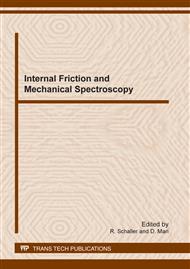[1]
W.G. Marshall Jr, S.J. Marshall, J.H. Kinney, M. Balooch, The dentin substrate: structure and properties relate to bonding, J Dent. 25 (1997) 441- 458.
DOI: 10.1016/s0300-5712(96)00065-6
Google Scholar
[2]
S. Amadori, E. Bonetti, I. Cappelloni, R. Montanari, Anelastic phenomena in human dentin above room temperature, Presented at ICIFMS-16 Losanna July (2011).
DOI: 10.4028/www.scientific.net/ssp.184.455
Google Scholar
[3]
D.H. Pashley, Dynamics of the pulpo-dentin complex, Crit. Rev. Oral. Biol. Med. 7 (1996) 103-133.
Google Scholar
[4]
J.H. Kinney, S.J. Marshall, G.W. Marshall, The mechanical properties of human dentin: a critical review and re-evaluation of the dental literature Crit. Rev. Oral. Biol. Med. 14 (2003) 13-29.
Google Scholar
[5]
J.H. Kinney, M. Balooch, S.J. Marshall, G.W. Marshall, A micromechanics model of the elastic properties of human dentine, Arch. Oral. Biol. 44 (1999) 813-822.
DOI: 10.1016/s0003-9969(99)00080-1
Google Scholar
[6]
J.C.W. Chien, E.P. Chang, Dynamic mechanical and rheo-optical studies of collagen and gelatin Biopolymers 11 (1972) 2015-(2031).
DOI: 10.1002/bip.1972.360111003
Google Scholar
[7]
S. Nomura, A. Hiltner, J.B. Lando, E. Baer, Interaction of water with native collagen, Biopolymers 16 (1977) 231-246.
DOI: 10.1002/bip.1977.360160202
Google Scholar
[8]
E. Baer, R. Kohn, Y.S. Papir, Mechanical relaxation behavior of collagen, polyglycine I, and nylon 6 in the range from 77° to 420° K, J. Macromol. Sci. Part B Phys. (1972) 761-774.
DOI: 10.1080/00222347208212569
Google Scholar
[9]
H. Stefanou, A.E. Woodward, D. Morrow, Relaxation behavior of collagen Biophys. J. 13 (1972) 772-779.
Google Scholar
[10]
M. Fois, A. Lamure, M.J. Fauran, C. Lacabanne, Study of human cortical bone and demineralized human cortical bone viscoelasticity J. Appl. Polym. Sci. 79 (2001) 2527-2533.
DOI: 10.1002/1097-4628(20010401)79:14<2527::aid-app1061>3.0.co;2-j
Google Scholar
[11]
S. Amadori, E.G. Campari, A.L. Fiorini, R. Montanari, L. Pasquini, L. Savini, E. Bonetti, Automated resonant vibrating-reed analyzer apparatus for a non-destructive characterization of materials for industrial applications. Mater. Sci. Eng. A 442 (2006).
DOI: 10.1016/j.msea.2006.02.210
Google Scholar
[12]
B. J. Murray and A. K. Bertram, Formation and stability of cubic ice in water droplets. Phys. Chem. Chem. Phys 8 (2006) 186-192.
DOI: 10.1039/b513480c
Google Scholar
[13]
G. P. Johari, Crystallization kinetics of water below 150 K. J. Chem. Phys. 122 (2005) 2743-2747.
Google Scholar
[14]
W.X. Zhang, C. He, J. S. Lian, Q. Jiang, Selected crystallization of water as a function of size. Chem. Phys. Lett. 421 (2006) 251-255.
Google Scholar
[15]
T.C. Hansen, A. Falenty, W.F. Kuhs, in: Physics and Chemistry of Ice, W. Kuhs (Eds. ), Royal Society of Chemistry, Cambridge, 2007, pp.201-208.
Google Scholar
[16]
O. Mishima, L.D. Calvert, E. Whalley, Melting ice, I at 77 K and 10 kbar: a new method of making amorphous solids. Nature 310 (1984) 393-395.
DOI: 10.1038/310393a0
Google Scholar
[17]
O. Mishima, Reversible first-order transition between two H2O amorphs at ~0. 2 GPa and ~135 K. J. Chem. Phys. 100 (1994) 5910-5912.
DOI: 10.1063/1.467103
Google Scholar
[18]
T. Loerting, C. Salzmann, I. Kohl, E. Mayer, A. Hallbrucker, A second distinct structural state of high-density amorphous ice at 77 K and 1 bar. Phys. Chem. Chem. Phys. 3 (2001) 5355-5357.
DOI: 10.1039/b108676f
Google Scholar
[19]
F. Franks, Biophysics and Biochemistry at Low Temperatures, Cambridge University Press, Cambridge, (1985).
Google Scholar
[20]
J. Urquidi, C. J. Benmore, P. A Egelstaff , M. Guthrie, S.E. McLain, C.A. Tulk, D.D. Klug, J.F.C. Turner, A structural comparison of supercooled water and intermediate density amorphous ices. Mol. Phys. 102 (2004) 2007-(2014).
DOI: 10.1080/00268970412331292650
Google Scholar
[21]
P.G. Debenedetti, H.E. Stanley, Supercooled and glassy water. Phys. Today 6 (2003) 40-46.
Google Scholar


